e-Francisco Motor Corporation
TsuperHero Program
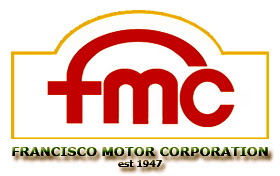
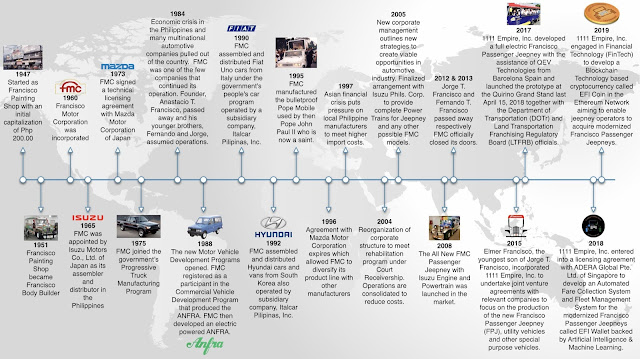
COMPANY PROFILE
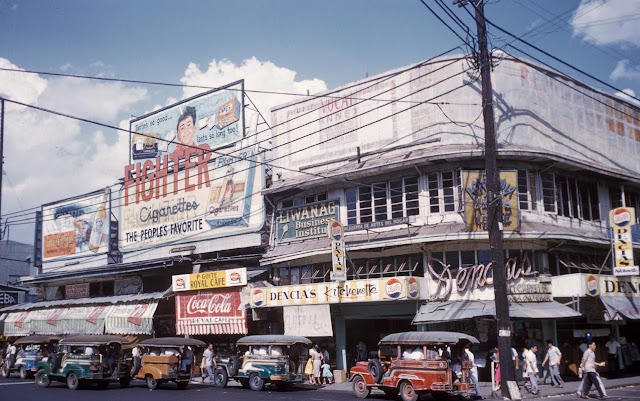
FMC Passenger Jeepneys in the olden days
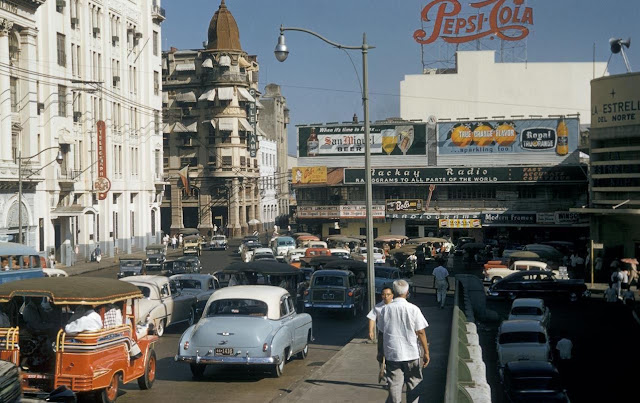
FMC Passenger Jeepneys in Binondo
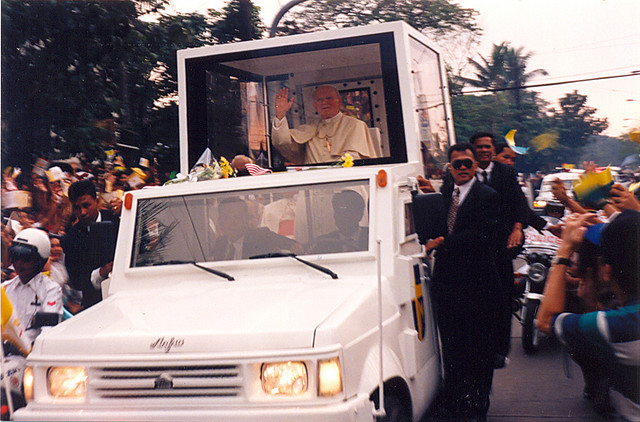
ANFRA Pope Mobile in 1995 with then Pope John Paul II inside
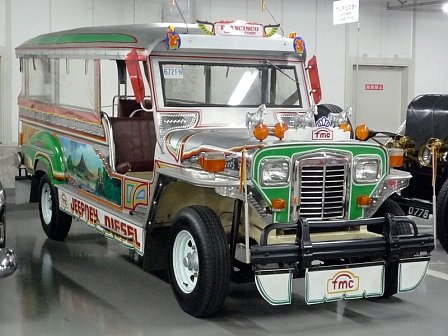
FMC Passenger Jeepney in a Museum

History of Francisco Motor Corporation
In 1947, Anastacio Trinidad Francisco established a small painting shop in Zapote, Las Pinas with a starting capital of Php 200.00 that specialized in painting jeepneys, cars and trucks.
Four years later, the small painting shop became the Francisco Body Builder (FBB) which engaged in the building of jeepney bodies. It became known as a reputable body builder with clients coming to the shop for the unique body designs from surplus jeepneys left after the war.
By 1955, FBB ventured into assembling a complete line of jeepneys using reconditioned engines from Japan. Also in the same year, the Luneta Motor Company became the company’s first distributor of FBB bodies. This marketing relationship continued to blossom and Luneta Motor Company – which was the franchised distributor of American Ford cars and Thames trucks – partnered with FBB to assemble Ford Consul and Thames light trucks.
The company was incorporated in 1960 and was to be known by its present name: Francisco Motor Corporation. As its name continued to be firmly established in the local automotive industry, FMC was appointed by Isuzu Motors Co., Ltd. of Japan as the franchised assembler and distributor of the Isuzu Bellett Cars in the Philippines. By 1968, FMC assembled Isuzu Elf trucks and continued its partnership with Isuzu until 1974. With its partnership with Isuzu, FMC introduced Isuzu diesel engines for the locally distributed jeepneys. FMC continued to dominate the jeepney market with its partnership with Isuzu of Japan.
Due to changes in the local market, FMC next partnered with Mazda for a new line of lights trucks for commercial use. This proved to be successful and FMC broadened its partnership with Mazda for other commercial vehicles as well as the provision of engines for its locally produced jeepneys and mini-buses.
The continued partnership with Mazda allowed FMC to actively participate and pioneer the development of the Asian Utility Vehicle under the government’s Progressive Truck Manufacturing Program. This resulted in the introduction of the Pinoy I, a Mazda 1200 cc powered vehicle, which was widely used at the Cultural Center of the Philippines. Further improvements on the Pinoy and a new version was introduced in 1979 as the Pinoy II.
At the same time, jeepney production reached 14,900 units. For the same period, FMC annual production reached 5,000 units per year and employed 2,000 employees in two manufacturing plants.
As the company moved into the turbulent 80s, FMC joined the Commercial Vehicle Development Program, which replaced the Marcos-era PTMP under the Board of Investments. Under the program, FMC developed the ANFRA – a third generation Asian Utility Vehicle that was mainly used for commercial use.
In 1984, founder Anastacio T. Francisco passed away and his brother Jorge T. Francisco who was a Mechanical Engineer took over the operations together with another brother, Fernando T. Francisco.
By the 1990s, FMC emerged as one of the largest and only locally owned manufacturer and assembler of vehicles in the Philippines with over 60,000 units sold. It further expanded into the assembly and distribution of small engine displacement cars under license from Fiat of Italy. As the contract with Fiat expired, FMC tied up with Hyundai of Korea to assemble and distribute Hyundai cars and vans.
As the 1990s closed, FMC had been a strong player in the local automotive market; however, due to the Asian financial crisis of 1997, the company had experienced a series of setbacks that affected the financial viability of the company after more than 50 years of continued operations and growth.
By 2002 the company had filed for rehabilitation due to losses incurred in its operations. The economy was devastated by the financial crisis and FMC was not spared.
By 2004, FMC reorganized its corporate structure to meet the rehabilitation program under Court Receivership. Operations were consolidated to reduce costs.
By 2005, the new corporate management outlined new strategies to create viable opportunities in the automotive industry which later on finalised the agreement with Isuzu Phils. Corp. to provide complete powertrains for jeepneys and any other possible FMC models.
By 2008, the all new FMC Passenger Jeepney with Isuzu engine and powertrain was launched.
By 2012, Jorge T. Francisco passed away followed by Fernando T. Francisco in 2013.
By 2015, Elmer Bautista Francisco, the youngest son of Jorge T. Francisco, incorporated 1111 Empire, Inc. to undertake joint venture agreements with relevant companies to focus on the production of the new Francisco Passenger Jeepney (FPJ), utility vehicles and other special purpose vehicles.
In 2017, the Department of Transportation of the Republic of the Philippines initiated the Public Utility Vehicles Modernization Program which aims to phase-out all Jeepneys that are 15 years old and older and replace them with brand new ones that conforms with the Philippine National Standards an
d powered by either an electric powertrain or at least a Euro 4 compliant diesel engine. To answer the call of the government for the PUV Modernization Program, 1111 Empire, Inc. developed a full electric Francisco Passenger Jeepney with the assistance of QEV Technologies from Barcelona Spain and launched the prototype at the Quirino Grand Stand last April 15, 2018 together with the Department of Transportation (DOTr) and Land Transportation Franchising Regulatory Board (LTFRB) officials.
In 2018, 1111 Empire, Inc. entered into a licensing agreement with ADERA Global Pte. Ltd. of Singapore to develop an Automated Fare Collection System and Fleet Management System for the modernized Francisco Passenger Jeepneys called EFI Wallet backed by Artificial Intelligence & Machine Learning.
In 2019, 1111 Empire, Inc. also engaged in Financial Technology (FinTech) to develop a Blockchain Technology based cryptocurrency called EFI Coin aiming to enable jeepney operators to acquire modernized Francisco Passenger Jeepneys.
In 2020, Elmer Francisco Industries, Inc. (EFI) with trade name Francisco Passenger Jeepney was incorporated with the Securities and Exchange Commission with an authorized capital stock of Php100million and a fully paid-up subscribed capital stock of Php100million. The primary purpose of the company is to manufacture all types of vehicles whether powered by internal combustion, electric or renewable energy. The secondary purpose is to efficiently operate the fleet of public utility vehicles.

FMC Passenger Jeepney Brochure Page 1
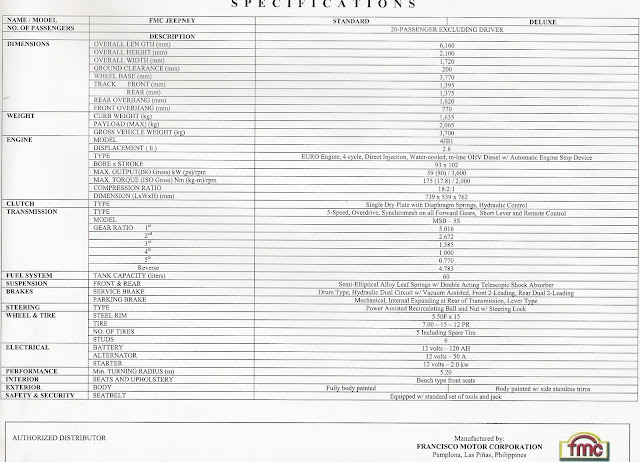
Corporate Highlights
- FMC Plant, FMC Compound, J. Aguilar Ave., Pamplona, Las Piñas City, Metro Manila Philippines
- Commercial Vehicle Development Program
- Categories I, II, III, & IV (July 18, 1988)
- Car Development Program (Italcar Pilipinas Inc.)
- Motorcycle Development Program (DAYE-FMC}
- FMC’s Parts Manufacturing Plant produces metal fabricated parts such as Vehicle Body and Chassis parts and Components
- FMC’s Assembly Plant is equipped with modern painting facilities such as the newly-installed CED Coating and Top Coat Line
- The FMC plant has a capacity of about 12,000 units per year based on a one shift operation. Depending on demand, more shifts can be added.
Model | Per Day | Per Month | Per Year |
Jeepney | 10 units | 200 units | 2,400 units |
Anfra | 10 units | 200 units | 2,400 units |
AnfraPick-up/Trucks | 14 units | 350 units | 4,200 units |
Vans | 6 units | 150 units | 800 units |
40 units | 1,000 units | 12,000 units |
- Pamplona Plant: 6.6 hectares
- Anfra AUV – Asian Utility Vehicles (cab, pick-up and transporter)
- Passenger Jeepney
- Special Military Vehicles
- Other custom-built, special purpose vehicles
Highlights of EFI’s Strategic Plan
- Company’s Strategic Thrust
- Return to Francisco Core Business
- Manufacturing and Assembly of Francisco Passenger Jeepney (FPJ) and Asian Utility Vehicles (AUV)
- Institutional Strengthening
- Professionalization of management and operations team
- Establishment of Management Committee
- Marketing Plan for Re-entry of Francisco Passenger Jeepney
- Develop new FPJ and AUV based on Isuzu Euro 4 compliant diesel platform & full electric platform
- Use 4JH1 diesel engine and powertrain
- Re-design and re-develop FPJ and AUV body and features
- Develop drive stability for new FPJ and AUV models
- Add new features to current models
- Conduct market review of existing FPJ and AUV market
- Determine potential market size nationwide
- Conduct pricing survey against current available models
- Determine competitors in the market both foreign and domestic
- Explore the current national government, local government, police and military transport requirements
- Explore the current utility companies’ transport requirements
- Develop marketing programs and financial plans
- Renew relationships with dealers nationwide
- Set-up spare parts and after sales service network in key areas in Metro Manila and key cities nationwide with existing dealer network and new potential dealers
- Discuss with financial institutions for possible assistance on sales financing
- Tap other distribution channels for FPJ and AUV
- Operators and drivers associations
- Establish links with Overseas Filipino Workers
- Tap new agricultural links for transport
- Develop new export markets (developing countries in Asia and Africa)
- Alignment with Government Programs and Thrusts
- Support the government’s PUV Modernization Program by replacing current aging jeepney fleet
- Assist in the development of road safety measures
- Work with appropriate government agencies to pursue alternative energy sources for transportation
FPJ and AUV Project Brief
- The objective of the new FPJ and AUV Project is to sell brand new FPJ and AUV in the Philippine market that will use either Isuzu powertrains or full electric powertrains together with locally assembled parts by Francisco.
The need to introduce new models to the Philippine jeepney and AUV market is aimed at addressing the current aging fleet of jeepneys in the public transport sector. It must be noted that the current fleet is on average more than 15 years old. With an aging fleet of jeepneys that are primarily reconditioned units or powered by second hand diesel engines, there is an urgent need to replace these with units that are compliant to the Clean Air Act. At present, there are approximately 250,000 jeepneys operating in the Philippines with concentration of operations in Metro Manila and its nearby provinces. In the other parts of the country, the jeepney represents a cheap and convenient means of transportation as well.
Based on the above, Elmer Francisco Industries, Inc., in partnership with Isuzu Philippines Corp. (IPC) and other relevant companies, is set to embark on a new program that addresses these major concerns of the Philippine transport sector.
The program intends to focus on the provision of competitively priced brand new jeepney units anchored on the Isuzu’s powertrain and full electric powertrain business. Based on market data, the secondary market for jeepneys sell on average at about Php2million with prices reaching Php2.5million. With this in mind, EFI believes that in order to penetrate the jeepney market with brand new jeepneys, pricing is a critical point. As such, the cost of manufacturing and assembly should be able to match current pricing practices and yet provide adequate margins in order to sustain operations. We believe that in order to re-develop the brand new jeepney market, we have to price competitively. In order to do this, we are looking at increased market share in the next 6 months and introduce our new jeepneys at about 15% to 20% above the competition due to brand value. This pricing strategy calls for managing our manufacturing costs and rely on Isuzu Philippines’ and other powertrain suppliers’ ability to provide cost effective powertrains. We estimate that in order to be competitive, powertrain costs would account for 50% of total selling price of the finished jeepney. We propose that this pricing strategy would offer an affordable and yet reliable brand new jeepney to the market. In addition to eating into the second hand market, this pricing strategy will not eat into the current AUV market.
The local transport market is expected to shift to newer models in order to comply with the PUV Modernization Program and at the same time establish more profitable operations. The major stumbling blocks that face jeepney owners and operators as well as assemblers and manufacturers are:- Absence of complete and affordable replacement units
- Proliferation of second hand diesel engines
- Continued increase in diesel fuel prices and higher maintenance costs
- High costs of new jeepneys
EFI intends to address these concerns through:- Introduction of brand new jeepneys that are PUVMP compliant using Isuzu’s powertrain or full electric powertrain together with locally sourced components that are affordable and fuel efficient
- Provide in-house financing for end-users to enable jeepney operators to replace their old jeepneys without negatively affecting their daily income
- Strengthen the current dealer network and set-up when needed new dealer channels to provide:
- Spare parts and after sales service in key sites in Metro Manila and key cities nationwide to ensure parts availability
- Strategic centers to assist operators and owners assess vehicle conditions and evaluate appropriate measures for possible replacement or
